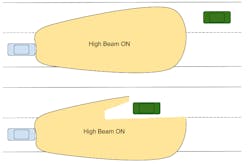Nvidia’s AI Prevents High-Beam Headlights from Producing Glare
A common cause of accidents in nighttime driving is glare from high-beam headlights, which can be distracting, and in the worst cases, could cause temporary blindness. Nonetheless, preventing glare traditionally has been left up to the driver to dim high beams when another vehicle is approaching.
In a blog post, Nvidia’s Drive Labs division revealed an AI camera-based system for automatic high-beam control. The researchers trained a camera-based deep neural network (DNN)—called AutoHighBeamNet—on camera images to automatically generate control outputs for the vehicle’s high-beam headlamp system, increasing nighttime driving visibility and safety.
AutoHighBeamNet is part of Nvidia’s AutoDrivingBeam visual perception module, which takes in image data from a front-facing camera. AutoHighBeamNet detections feed into a sub-module that performs both per-frame and temporal post-processing. The output of the module can then be customized by the auto OEM, subject to its rules and policies based on input signals from other vehicle modules (e.g. speed of the car, environmental illumination conditions, etc.). Based on these customizations, the final high-beam control signals are generated.
In ADB mode, a glare-free zone (GFZ) is created where either high beams are kept out completely or dimmed to avoid reflection.
The high-beam control signals can take on two different modes: auto-high-beam (AHB) mode and adaptive-driving-beam (ADB) mode, which provides precise control of individual high-beam LED arrays to create glare-free zones (GFZ). In AHB mode, the vehicle’s high-beam lights will automatically turn on in poorly illuminated nighttime driving conditions. However, when an active vehicle is detected, high beams will automatically turn off and switch to low beam. Nvidia defines an active vehicle as any automobile with its headlight or taillight turned on.
After the active vehicle passes by, the high beams will turn back on automatically. Rather than generating control signals based on lux levels of other light sources, Nvidia says the AutoHighBeamNet reacts to active vehicles in the camera frame (roadside parked vehicles with their lights turned off are ignored).
Similar to AHB mode, after the active vehicle exits the scene, the dimmed area will turn back to full luminance automatically. Consequently, in ADB mode, high beams can always be kept on for better nighttime driving safety, without causing glare to other road users.
ADB was adopted in Europe in 2016. It’s also under active evaluation in the U.S. by the NHTSA, although it hasn’t yet been ratified and approved for the U.S. market.


